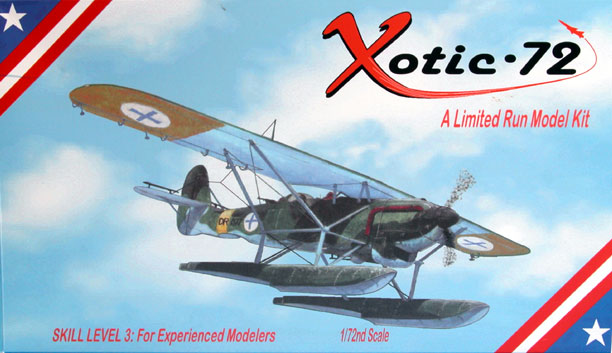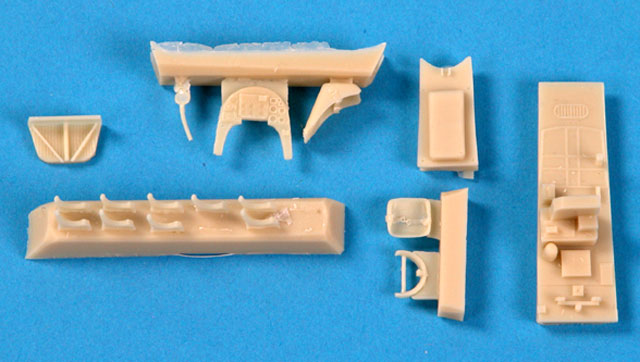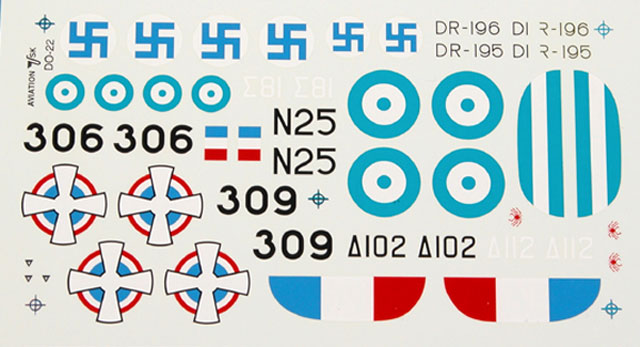|
Dornier Do-22K/L

Xotic-72 (Aviation Usk Nebraska)
|
S u m m a r y |
| Description
and Item Number: |
#2026 - Dornier
Do-22K/L |
| Scale: |
1/72 |
| Price: |
USD$24.95 from Aviation Usk |
| Review Type: |
FirstLook |
| Contents and Media: |
58 pieces in long-run
injection molded plastic; 2 parts in vacuum formed plastic;
18 pieces in resin |
| Advantages: |
Unusual subject
(believed to be the first injection kit of this subject); the instructions
are very well done for what looks like it might be a complex build (the
strut arrangement is very complex); optional floats or wheeled landing gear;
excellent decals |
| Disadvantages: |
Though explained in
the instructions, the locating holes for the struts will have to be filled
in and new ones drilled (though I am glad that they caught this, and not me) |
|
Recommendation: |
Recommended |
Reviewed by Stephen Munroe

HyperScale is proudly supported by
Squadron.com
Not another Luftwaffe plane! You may say this but you would not be entirely
accurate. The Do-22 was
developed by Dornier in the mid-1930s as an export only aircraft. Production
aircraft never flew with German markings, though the prototype did. This Dornier
was a three place torpedo bomber/reconnaissance seaplane, with a single parasol
wing. The prototype and most of the production aircraft were in the seaplane
configuration, though there was a land plane configuration developed as well.
The prototype of the Do-22 first flew in 1935, with production machines
following in July of 1938. The land plane variant first flew in 1939. There was
a total of 31 airframes built.
The first deliveries of the Do-22K, twelve aircraft, went to Yugoslavia in 1938.
Greece and Latvia were the other original customers, but Latvia was never
destined to see theirs before being absorbed by the Soviet Union. Four aircraft
originally intended for Latvia were sent to Finland by the German government.
The Yugoslav machines saw service against Germany in the Mediterranean. The
Greek machines were lost in the battle against Germany.
The plastic parts in this kit are well molded - about the equivalent MPM's
less recent kits. Surface detail is good on the fuselage, with decent and not
too heavy fabric representation on the rear fuselage. The overall shape of the
fuselage looks good compared to the photos that I have of the Do-22.
Click the thumbnails below to view
larger images:
Wing surface detail is minimal (I suspect that there are not many detail photos
of this area), with a few panel lines representing the upper surface detail. The
only problem that I see here is that the lines are all the same width and depth,
but I like to see a little more definition for the control surfaces so that they
look like they are movable. I do not have any photos of the Do-22 from above,
but the shape looks right compared to the simple drawings that I have. There are
no rigging instructions other than the illustration on the first page of the
instruction sheet. Both the wingspan and fuselage scale out to published
dimensions.
The resin cockpit parts are nicely executed with the floor, two seats,
instrument panel and control column. The seats have the belts molded into them.
One thing that is absent from the kit is side wall detail, there is nothing but
smooth plastic on the inner surface of the fuselage. The machine guns (two MG15s
are molded in plastic), and are a little heavy compared to the resin pieces that
make up the rest of the cockpit. There is also a separate floor for the tunnel
gunner, with a pad on it, that is also made of resin.

The kit supplies plastic struts but mentions in the instructions that they can
be replaced by Aeroclub Strutz or Contrail strut stock.
One item of note:
apparently sometime after the masters and molds were made the kit designers
discovered that the mounting holes for the wing struts were not in the correct
place. There is a full page showing how to overcome this by filling the holes
and drilling new ones. This explanation comes from Matt Bittner, who
occasionally posts here on Hyperscale. Kudos to Aviation Usk for catching this.
The struts are quite a handful on this model, there being fourteen individual
pieces to mount the wing, and an additional eight to mount the floats (only four
for the wheeled configuration).
There are ten resin pieces that mount on the underside of the wing that are the
aileron (flaperon?) actuators. All pictures I have seen of the Do-22 also show
counterweights on the ailerons, but these do not appear in the kit. The
horizontal stabs and elevators are just butt joints to glue to the fuselage, and
could use with a pin to strengthen them. There are small plastic winglets or
trim fins that attach to the top of the horizontals that need the mounting pins
made from rod or wire not supplied in the kit.
 Finally,
the windscreen pieces are vacuum formed, and quite clear. These attach to the
front of both cockpit openings (click thumbnail to right to view larger image). Finally,
the windscreen pieces are vacuum formed, and quite clear. These attach to the
front of both cockpit openings (click thumbnail to right to view larger image).
There are markings for six machines in this kit, two each from Finland,
Yugoslavia and Greece. It is a good mixture of camouflaged and overall silver
airplanes.

There are two Yugoslav seaplanes, one camouflaged and one mottled
green over silver (or light gray). There are two Finnish airplanes in the green
and black green over light blue, one a seaplane and one with wheels. The Greek
machines are a camouflaged landplane and a silver seaplane. The decal quality
looks very good, thin with good color saturation and alignment.
I think that modelers of 1/72nd WW II and pre-war aircraft will find this an
interesting subject. But it will also be a bit of a challenge, with all of the
strut work. I am looking forward to building this model.
Recommended.
Thanks to Aviation Usk for the review sample.
X-otic 72 kits are available from
Aviation Usk's website
Review Copyright © 2002 by
Stephen Munroe
This Page Created on 07 September, 2002
Last updated 22 July, 2003
Back to HyperScale
Main Page
Back to Reviews
Page
|
Home | What's
New | Features
| Gallery |
Reviews | Reference
| Forum
| Search